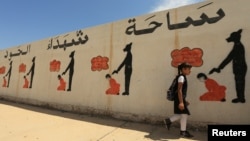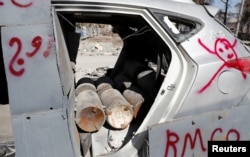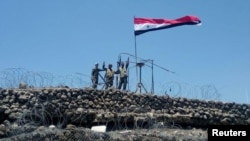The latest numbers from the U.S.-led coalition to destroy the Islamic State terror group appear, at first glance, to be damning.
A self-declared caliphate that once ruled vast swaths of Iraq and Syria has been reduced to about 300 square kilometers in eastern Syria, military officials say.
"They're really in the disarray. They're in a really disorganized manner," French Brig. Gen. Frederic Parisot, director of civil-military operations for the coalition told Pentagon reporters Tuesday, estimating "a few hundred" IS fighters are likely left.
But as has been the case with much of the fight against IS, there are longstanding concerns that the estimates are off and that even a diminished IS fighting force is larger and more capable than the rest of the intelligence would suggest.
"One ISIS fighter is one too many," Parisot noted, using an acronym for the terror group.
"We're still engaged in major combat operations," he said. "I won't speculate on when this is going to end."
Other U.S. military officials questioned on the size of the IS threat in Syria have also been hesitant to discuss specifics.
"They're still carrying out attacks," a senior U.S. military official told VOA when asked about IS forces. "So obviously the capacity is there."
Quantifying the threat
Counting IS fighters and quantifying the threat has long been a tricky and controversial endeavor.
At the terror group's peak in 2015, U.S. military and intelligence officials said IS likely had about 33,000 fighters at its disposal — an admittedly conservative estimate that remained constant for months. Other U.S. officials maintained at least 50,000 IS fighters had been killed in coalition airstrikes.
Military and intelligence officials pointed to the terror group's ability to recruit, for a while replenishing its ranks with as many as 2,000 foreign fighters a month, as one reason IS was able to maintain constant numbers.
Even so, independent analysts often doubted the official estimates, criticizing them for being too low. Some still do.
"I don't think anyone knows for certain, but hundreds is likely too small," said Thomas Joscelyn, a senior fellow at the Foundation for Defense of Democracies.
"The Islamic State isn't anywhere near the zenith of its power, but it isn't an ant hill either," he said. "They knew the US-led forces were going to eject them from their territory, and they didn't plan on losing all their fighters."
On the higher end, independent estimates say in addition to hundreds of IS militants putting up a fight against U.S.-backed forces in areas along the Syria-Iraq border, there could be another 7,000 to 9,000 fighters in Syria alone.
U.S. officials, though, remain cautious about sharing any numbers.They say even getting a sense of how many IS fighters are left has been complicated as many have slipped into the background, some biding their time as members of small sleeper cells, waiting for the right time to strike.
"Even on the Iraq side of the border — because I think it applies there, too — in areas that have been cleared, that's something that will continue to be a challenge for us and the Iraqis, is really understanding how robust the remaining ISIS presence is," Christopher Maier, the director of the Pentagon's Defeat ISIS Core Task Force told VOA.
IS resurgence?
Iraqi officials have been warning of a looming threat from sleeper cells for more than a year, voicing particular concerns about cells of teenagers young enough that they could not be touched by counterterror forces, but old enough, and sufficiently brainwashed, to carry out Islamic State attacks in the future.
Already, there are concerns in Iraq that such fears are coming to fruition with some pointing to this week's attack by three suspected IS gunmen on a government building in Erbil.
Kurdish officials in Erbil identified two of the gunmen as 16 years old and the third as only 18.
The pace of IS-claimed attacks in Iraq have also been steadily rising and even U.S. officials have expressed concern, noting the threat from the terror group extends all the way to Baghdad.
There are also concerns that IS fighters and operatives — hundreds of them at the very least — may be finding some refuge in parts of Syria that are being cleared by forces loyal to Syrian President Bashar al-Assad and backed by Russia.
"We're going to continue to be challenged by that fundamental question, which is you don't know there's an ISIS presence in a regime-held area until it becomes manifest," Maier said.
"The regime and it's Russian backers haven't proved capable or in some cases willing to take on that ISIS threat," he added.
And of late, IS has sought to flex its muscle in such areas. The Syrian Observatory for Human Rights said IS suicide bombers killed more than 200 people in a string of suicide attacks Wednesday in Sweida province in southern Syria.
The attacks, the group said, seemed to be a response to a Syrian regime, Russian-backed effort to clear Islamic State militants from a neighboring area.
Speaking prior to the latest attacks, U.S. official said they expect the terror group to carry out more such attacks, describing the IS strategy as a "clandestine insurgency."
They fear the longer IS finds a way to keep going, the more potent it will become, and the less traditional military tactics may be of use.
"ISIS is more than a physical group. It's an idea," a senior U.S. official said. "That's what we've been fighting."












